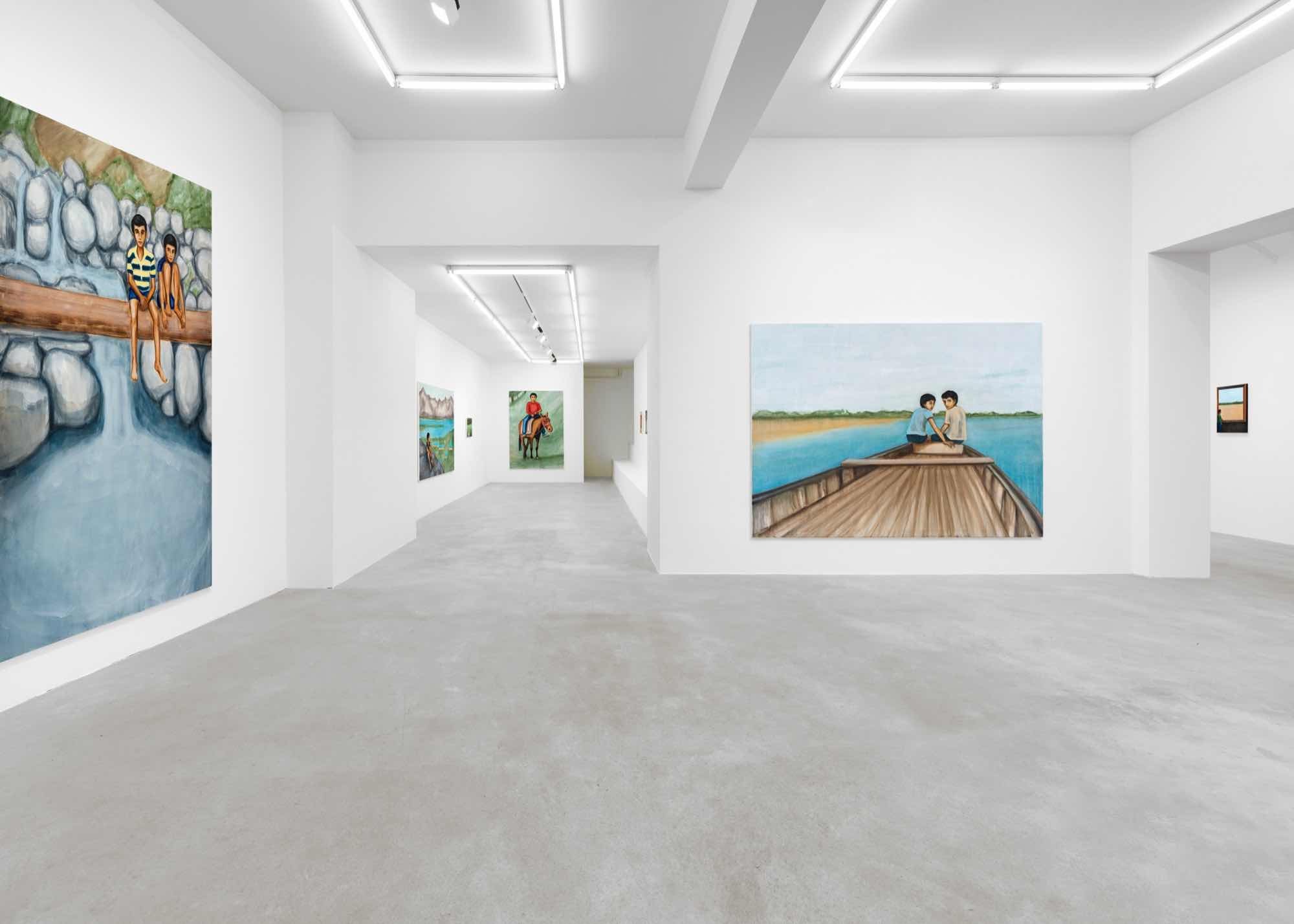Matthew Krishanu
Arrow and Pulpit
06 Nov - 18 Dec 2021
Tanya Leighton is pleased to announce the opening of Matthew Krishanu’s ‘Arrow and Pulpit’, an exhibition of the artist’s ongoing exploration of his childhood in South Asia. On view are selections from the artist’s ‘Another Country’ and ‘Mission’ series, paintings that explore the two realms of Krishanu’s memories of Dhaka: that of a boy in the midst of a world of adventure and play and that of a son born to an English priest and a Bengali Indian mother. By using photography as a departure point, Krishanu’s art is as much a contemplation of capturing time as it is about religious doctrine. In other words, his work meditates on how the latter conditions the lived experience of the former in a manner that raises questions about Western imperialism’s afterlife in South Asia—somehow, embedding both these concerns in the most commonplace of scenes.
Like the photographs one might find stored away in a family album, Krishanu’s portraits capture ordinary moments of church life in Bangladesh. Paintings like Congregation (2021), Woman and Chalice (2019), and Three Figures (Crucifixion) (2021) are peculiar not only for the manner in which the artist depersonalises his subjects—in both figure and title—but also the detachment with which he depicts Christianity’s rituals. Detachment is, indeed, the most palpable feeling of Krishanu’s aesthetic sensibility, which makes great use of thinned oil paint and pared-down compositions to make his subjects feel distant, yet still possessing a sense of interiority. This is the mood that marks all of Krishanu’s portraits, inflecting every image with a kind of uneasy withdrawal, an atmosphere that arts critic Ben Luke recently described as a “productive ambiguity.”
Krishanu’s studies thus possess an intimate but distanced relationship to Christianity’s machinery. The paintings do not merely record the advancement of Western cosmology into the life world of another culture; rather, they reflect an unwillingness to enter into Christianity’s temporal regimen, structured around countless ceremonies and symbols. Detachment in Krishanu’s work strikes one as an attempt to hold Western, disciplinary time at a critical remove or, alternatively, to refuse its capture. Therefore, capture seems to be one operative motif in Krishanu’s art, one that may shed light on the recurrent figures of two boys that exist almost like two protagonists in his world.
In stark contrast to the incidental character of the mission paintings, the boys in Archers (2021), Riverboat (2020), and Boy on a Horse (2021) are unmistakably grounded, posed in the landscape in scenes of adventure and exploration. Notably, Krishanu does not offer any images of the boys participating in the mission’s life; rather, they exist in their own world—alone in the landscape. The exception to this is Bedroom (Last Supper) (2021), where the two boys are shown in an interior space, with a copy of Da Vinci’s Last Supper above their bed, hinting at the overlapping world of the mission and the two boys. In the boys’ world, the mission may as well be a subtle but recurring intrusion into their own private, lived experience of time outside the mission’s regimen.
In Krishanu’s paintings, ‘time’ takes on manifold metaphoric registers—as divinely boundless, as disciplinary capture, and as imperialism’s afterlife. Matthew Krishanu’s talent, to be sure, is that he manages to embed all these complex concerns in the most deceptively simple of images, thereby raising questions about how imperialism’s afterlife is still impacting the lived experience of South Asia and its diasporas.
Like the photographs one might find stored away in a family album, Krishanu’s portraits capture ordinary moments of church life in Bangladesh. Paintings like Congregation (2021), Woman and Chalice (2019), and Three Figures (Crucifixion) (2021) are peculiar not only for the manner in which the artist depersonalises his subjects—in both figure and title—but also the detachment with which he depicts Christianity’s rituals. Detachment is, indeed, the most palpable feeling of Krishanu’s aesthetic sensibility, which makes great use of thinned oil paint and pared-down compositions to make his subjects feel distant, yet still possessing a sense of interiority. This is the mood that marks all of Krishanu’s portraits, inflecting every image with a kind of uneasy withdrawal, an atmosphere that arts critic Ben Luke recently described as a “productive ambiguity.”
Krishanu’s studies thus possess an intimate but distanced relationship to Christianity’s machinery. The paintings do not merely record the advancement of Western cosmology into the life world of another culture; rather, they reflect an unwillingness to enter into Christianity’s temporal regimen, structured around countless ceremonies and symbols. Detachment in Krishanu’s work strikes one as an attempt to hold Western, disciplinary time at a critical remove or, alternatively, to refuse its capture. Therefore, capture seems to be one operative motif in Krishanu’s art, one that may shed light on the recurrent figures of two boys that exist almost like two protagonists in his world.
In stark contrast to the incidental character of the mission paintings, the boys in Archers (2021), Riverboat (2020), and Boy on a Horse (2021) are unmistakably grounded, posed in the landscape in scenes of adventure and exploration. Notably, Krishanu does not offer any images of the boys participating in the mission’s life; rather, they exist in their own world—alone in the landscape. The exception to this is Bedroom (Last Supper) (2021), where the two boys are shown in an interior space, with a copy of Da Vinci’s Last Supper above their bed, hinting at the overlapping world of the mission and the two boys. In the boys’ world, the mission may as well be a subtle but recurring intrusion into their own private, lived experience of time outside the mission’s regimen.
In Krishanu’s paintings, ‘time’ takes on manifold metaphoric registers—as divinely boundless, as disciplinary capture, and as imperialism’s afterlife. Matthew Krishanu’s talent, to be sure, is that he manages to embed all these complex concerns in the most deceptively simple of images, thereby raising questions about how imperialism’s afterlife is still impacting the lived experience of South Asia and its diasporas.

